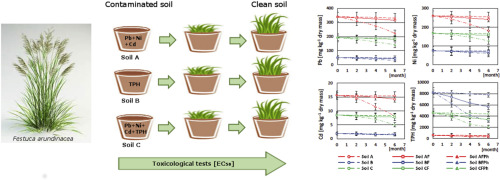Ecotoxicology and Environmental Safety ( IF 6.2 ) Pub Date : 2020-03-07 , DOI: 10.1016/j.ecoenv.2020.110409 Teresa Steliga 1 , Dorota Kluk 1

|
Phytoremediation is a promising „green technique" used to purify contaminated soils. The performed phytoremediation experiments assisted by the fertilization process involving pots of F. arundinacea grown on soils with diverse concentrations and types of contaminations produced the following decreased percentages after 6 months: Pb (25.4-34.1%), Ni (18.7-23.8%), Cd (26.3-46.7%), TPH (49.4-60.1%). Primarily, TPH biodegradation was occurring as a result of basic bioremediation stimulated by adding optimal volumes of biogenic substances and corrections in the soil reaction, while phytoremediation improved this process by 17.4 - 23.1%. The highest drop in a range of 45.6 - 55.5% was recorded for the group of C12-C18 hydrocarbons, with the lowest one for C25-C36, amounting to 9.1-17.4%. Translocation factor values were: TF<1 and ranged, respectively, for: Pb (0.46-0.53), Ni (0.29-0.33), and Cd (0.21-0.25), which indicate that heavy metals absorbed by Festuca arundinacea they mainly accumulated in the root of the tissue in descending order: Cd <Ni <Pb, showing poor metal translocation from roots to shoots. Co-occurrence of petroleum pollutants (TPH) in contaminated (Pb, Cd, Ni) soils results in reducing their contents in Festuca arundinacea roots. The process of phytoremediation of contaminated soil using F. arundinacea assisted with fertilization was monitored by means of toxicological tests: Microtox SPT (inhibition of the luminescence of V. fischeri), Ostracodtoxkit F (mortality, growth inhibition Heterocypris incongruens) and MARA (growth of 11 microorganisms) and Phytotoxkit F (germination assessment, inhibition root growth: Sorghum saccharatum, Lepidium sativum and Sinapis alba). The sensitivity of toxicological tests used was comparable and increased in the order: MARA<Ostracodtoxkit<Microtox. The performed phytotoxicity tests have indicated variable sensitivity of the tested plants on contaminants occurring in the studied soils, following the sequence: L. Sativum<S. saccharatum<S. alba. The obtained results indicate a decrease in soil toxicity during phytoremediation assisted by the fertilization process using Festuca arundinacea, which correlates with a decrease in the amount of harmful impurities contained in soils subjected to phytoremediation.
中文翻译:

Festuca arundinacea在修复被Pb,Ni,Cd和石油碳氢化合物污染的土壤中的应用。
植物修复是用于净化污染土壤有希望的“绿色技术”通过涉及的盆受精过程协助进行植物修复的实验。F. 茅上具有不同浓度和类型的污染土壤上种植产生以下6个月后降低百分比:铅( (25.4-34.1%),镍(18.7-23.8%),镉(26.3-46.7%),TPH(49.4-60.1%)。主要是通过添加最佳量的生物物质刺激基本生物修复,TPH发生生物降解以及土壤反应的校正,而植物修复使这一过程提高了17.4-23.1%,C 12 -C 18组的最高降幅为45.6-55.5%。碳氢化合物中,C 25 -C 36最低,为9.1-17.4%。Pb(0.46-0.53),Ni(0.29-0.33)和Cd(0.21-0.25)的易位因子值分别为TF <1和范围,这表明重金属被Festuca arundinacea吸收的重金属主要积累在其中组织的根部降序排列:Cd <Ni <Pb,从根部到芽的金属易位。在受污染的(Pb,Cd,Ni)土壤中共存石油污染物(TPH)会导致其在Festuca arundinacea根中的含量降低。污染土壤植物修复的使用过程中F. 茅受精辅助用的毒理试验来监测:了Microtox SPT(的发光的抑制V.鲵),Ostracodtoxkit F(死亡率,生长抑制Heterocypris incongruens)和MARA(11种微生物的生长)和Phytotoxkit F(发芽评价,抑制根的生长:高粱,小花吊钩草和白叶芥。所使用的毒理学测试的敏感性是可比的,并且以下列顺序增加:MARA <Ostracodtoxkit <Microtox。进行的植物毒性测试表明,被测植物对研究土壤中所含污染物的敏感性不同,顺序如下:L. Sativum <S. saccharatum < S.粉。所获得的结果表明,通过使用金合欢(Festuca arundinacea)的施肥过程,在植物修复过程中土壤毒性降低,这与进行植物修复的土壤中所含有害杂质的量减少有关。











































 京公网安备 11010802027423号
京公网安备 11010802027423号